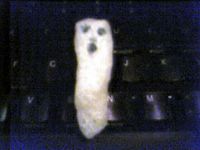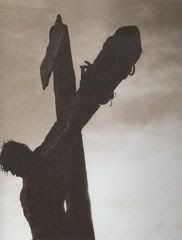The Greatest Story, Newly Told
Mel Gibson on "The Passion," and the passion behind it.
BY RAYMOND ARROYO
Friday, March 7, 2003 12:01 a.m. EST
ROME--Bounding around Studio 5 on the Cinecittà lot, not far from the catacombs, Mel Gibson is giving the performance of his life. In the shadow of an olive tree, wrapped in blue fog, he is at first a trembling Judas yanking at his lip, now a torch-toting member of Herod's guard. After expelling a cough (the remnant of a flu bug) and running a hand though his mane, he is suddenly a placid Messiah.
Sadly, none of this is being captured on film. But the athletic directing style betrays a zeal--an almost spiritual possession--to tell a story still confined to Mr. Gibson's mind yet known to millions. "It's going longer than I'd like," he whispers, as the actors try to copy his performance. "They've got to get into my head to see what I see . . . and you should see what it looks like from the inside." With a roll of his eyes, he is back on set demonstrating for the Italian day players.
Today the actor-director is shooting the arrest of Jesus in the Garden of Gethsemane for "The Passion," his first directorial effort since the Academy Award-winning "Braveheart" (1995). This arresting, graphic production explores the torture and death of Jesus Christ. Aside from a single press conference and a couple of interviews, Mr. Gibson has not spoken at length about his vision for the film or about the faith animating the production. But he recently granted me an interview and access to the set. I also received the first look at a rough cut of the film.
Already "The Passion" has stirred passions--journalists are trying to figure out what Mr. Gibson is about, whether he will bring some eccentric view to the Passion story, perhaps giving offense or pushing an agenda. Mr. Gibson is painfully aware of the digging around that is going on, as if, with this movie, he is suddenly striking out in a new direction that requires investigation.
But "The Passion" should come as no surprise. Since Mr. Gibson's directorial bow, "The Man Without a Face" (1993), his work has shown a Catholic sensibility. "Braveheart," "We Were Soldiers," "Signs": Each dealt with sacrificial heroes who rely on their faith for survival. Mr. Gibson's current project was conceived during a reappraisal of his life 13 years ago. "I read the New and Old Testaments and tried to just focus on that to maintain myself," he says. Reflecting on Catholic theological works and the sacrifice of Christ, he found various images surfacing. "I began to imagine what that must have been like," Mr. Gibson says. "I mean really like. No mere man could have survived this torture."
Based on the Gospel accounts, the dramatic visions of Blessed Anne Catherine Emmerich (a 17th-century stigmatic) and "The Mystical City of God" by Venerable Mary of Agreda (a 17th-century nun), "The Passion" focuses almost exclusively on the sacrifice of Christ. "We are talking about the single event that influenced civilization as we know it: the law, the arts, our knowledge of good and evil," Mr. Gibson says. "It has touched every possible aspect of everyone's life whether they realize it or not."
To underscore Christ's physical sacrifice, Mr. Gibson and special-effects artists have created some of the most graphic scenes ever committed to celluloid. To become the brutalized Jesus, actor Jim Caviezel ("The Count of Monte Cristo") often spent up to eight hours a day in the makeup truck. Buried under a wig and prosthesis, he may be the most Semitic-looking Jesus ever on screen. He endured 15 days on a cross in freezing weather, a separated shoulder, the flu and literal scourging for the role. "One day they missed the board on my back and hit me full on. It hurt so badly I couldn't find my voice to scream," Mr. Caviezel says. "I see people pulling Jesus off the cross these days. They just don't want to see how he suffered, but this is what happened."
Dissatisfied with "cheesy" portrayals that miss the political situation and "prettify" the torture and death of Christ, Mr. Gibson is struggling to recapture the historical reality, right down to the clothing and eating customs of the Jews under the old law--to "make it truly about a man born to the House of David." "The Passion" is being shot in Aramaic, Latin and Hebrew with no subtitles--a point of honor for Mr. Gibson. "There is power and mystery in these dead languages, and this is what was spoken at the time," he says. The movie will rely on its visuals to tell the tale.
Does it all work? Can the images convey the story? Will audiences endure dead languages they don't understand? And is the violence too much? Having seen a half-hour of the 90-minute film, I must say that it is as disturbing as it is comforting. It's like watching a documentary by Caravaggio. The images are so vivid, and the story so familiar, that language becomes almost incidental.
At moments Mr. Caviezel looks like a bloodied skeleton. Wearied and stumbling, with one eye swollen shut, he keeps a knowing dignity and strength. The violence, though intense, is never gratuitous, at least in the rough cut I saw. It rescues Christ from myth and grounds him in a reality that makes his actions more heroic.
Mercifully, Mr. Gibson has chosen to interrupt the brutality with artistic breathers: flashbacks to the Last Supper and to Christ's early life. At one point we see Christ fall under the weight of the cross through the eyes of his mother. For a moment we flash back to the child Jesus falling near his home as a concerned Mary rushes to console him. Now on the harsh streets of Jerusalem, she can do nothing but watch her boy suffer.
Focusing on the trial and death of Christ will inevitably cause some controversy. "This is dangerous territory we're in here," Mr. Gibson admits. As for the question of blame for Christ's crucifixion--a vexed subject that has fueled anti-Semitism over the centuries--Mr. Gibson says that "this is not a Christian vs. Jewish thing--'He came into the world and it knew Him not.' Looking at Christ's crucifixion, I look first at my own culpability in that."
Potential controversy aside, the whole project has been a challenge. "There have been a lot of obstacles thrown in the way of this picture; it's full of discomfort," Mr. Gibson confides. "And I understand it's the other realm warring. So I have taken steps to put on armor." A priest says Mass on the set each day. I also notice that Mr. Gibson wears a crucifix and brown scapular around his neck; Mr. Caviezel carries relics of the saints in his costume during shooting. "And I try to stay squeaky clean," Mr. Gibson adds. "For Mel and Jim, their belief is their whole lives, and they are committed to telling this story," Steve McEveety, Mr. Gibson's producer and partner, observes.
Back in Studio 5, Mr. Gibson is like a giddy child. The actors have finally gotten the arrest scene right. "It's happening, it's happening. Ha. This is so cool," he sputters. Then: "OK. Take your places, one more time." Without the support of a studio or a distribution deal, Mr. Gibson and his Icon Productions are reportedly financing the $25 million project themselves, believing "The Passion" will find its audience. "I look at myself as a conduit here--a tool, using what God gave me," Mr. Gibson says. For those who still doubt the power of faith and the merits of sacrifice, one has only to peek into Studio 5 to see them in bold, passionate flower.
Mr. Arroyo is news director of EWTN, the world's largest religious TV network.





0 Comments:
Post a Comment
<< Home